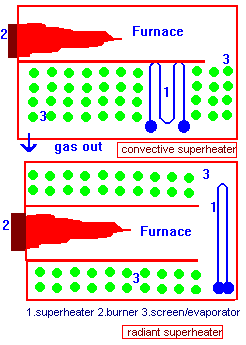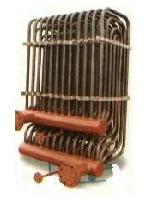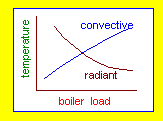Radiant
Superheater
 The
radiant superheater is located in a harsh environment. The furnace exit
gas temperature is one of the most difficult parameters to estimate. Several
variables affect furnace performance such as fuel type,analysis,excess
air,flue gas recirculation rate,burner design,presence of refractory in
the furnace and furnace dimensions to mention a few. Variations of 100-200
F from measured values are not uncommon. Radiant energy varies as the fourth
power of absolute temperature and hence a few degrees higher than estimated
value can transfer significant amount of radiant energy to the superheater,thus
increasing the tube wall and support temperatures,leading to failures. The
radiant superheater is located in a harsh environment. The furnace exit
gas temperature is one of the most difficult parameters to estimate. Several
variables affect furnace performance such as fuel type,analysis,excess
air,flue gas recirculation rate,burner design,presence of refractory in
the furnace and furnace dimensions to mention a few. Variations of 100-200
F from measured values are not uncommon. Radiant energy varies as the fourth
power of absolute temperature and hence a few degrees higher than estimated
value can transfer significant amount of radiant energy to the superheater,thus
increasing the tube wall and support temperatures,leading to failures.
 The
superheater is located in a region where it is difficult to predict the
performance accurately due to the 180 degree turn to the convection bank
and associated non-uniform gas temperature profile,turbulence and flow
pattern. The
superheater is located in a region where it is difficult to predict the
performance accurately due to the 180 degree turn to the convection bank
and associated non-uniform gas temperature profile,turbulence and flow
pattern.
 The
load versus enthalpy absorbed or steam temperature curve is shown for both
superheater types. The radiant superheater absorbs more energy at lower
loads,while the convective design absorbs more at higher loads. However
at low loads,due to low steam and gas velocities and associated pressure
drops,the flow maldistribution inside and outside the tubes will be much
higher.It is likely that some tubes may even be starved.Hence with uncertain
cooling inside tubes and higher radiant heat flux outside,the radiant superheater
is more likely to encounter tube failures. The
load versus enthalpy absorbed or steam temperature curve is shown for both
superheater types. The radiant superheater absorbs more energy at lower
loads,while the convective design absorbs more at higher loads. However
at low loads,due to low steam and gas velocities and associated pressure
drops,the flow maldistribution inside and outside the tubes will be much
higher.It is likely that some tubes may even be starved.Hence with uncertain
cooling inside tubes and higher radiant heat flux outside,the radiant superheater
is more likely to encounter tube failures.
 If
fuel oils containing sodium,vanadium are fired,the radiant design is likely
to be corroded at a faster rate due to the higher operating temperatures
and slag/deposit formation rate. If
fuel oils containing sodium,vanadium are fired,the radiant design is likely
to be corroded at a faster rate due to the higher operating temperatures
and slag/deposit formation rate.
 The
surface area required to transfer a given amount of energy will be lower
due to the higher log-mean-temperature difference and higher heat transfer
coefficient.Hence cost may be lower in spite of the better grade of materials
required. The
surface area required to transfer a given amount of energy will be lower
due to the higher log-mean-temperature difference and higher heat transfer
coefficient.Hence cost may be lower in spite of the better grade of materials
required.
|
Convective
Superheater
 Convective
superheater is located in a low gas temperature region-ranging from 300
to 1000 F lower,depending on the degree of superheat required. Since it
is shielded by several rows of screen tubes,the gas is well mixed and cooled
before it encounters the superheater and hence the performance can be predicted
more accurately. Convective
superheater is located in a low gas temperature region-ranging from 300
to 1000 F lower,depending on the degree of superheat required. Since it
is shielded by several rows of screen tubes,the gas is well mixed and cooled
before it encounters the superheater and hence the performance can be predicted
more accurately.
 At
lower loads,though the flow mal-distribution on gas and steam side is higher,it
is associated with much cooler gas and hence failures are rare compared
to the radiant design. At
lower loads,though the flow mal-distribution on gas and steam side is higher,it
is associated with much cooler gas and hence failures are rare compared
to the radiant design.
 Depending
on the degree of superheat,the superheater can be pushed further into the
convection bank,thus lowering the tube wall temperatures which require
lower grade tube materials. Life of the superheater is also thereby increased.
Using a radiant superheater irrespective of the degree of superheat
required is not sound engineering practice.A 50-200 F degree of superheat
can be well handled by a convective superheater shielded by several rows
of screen tubes.If the degree of superheat is say only 10-30 F,the superheater
can be even located between the evaporator and economizer! Depending
on the degree of superheat,the superheater can be pushed further into the
convection bank,thus lowering the tube wall temperatures which require
lower grade tube materials. Life of the superheater is also thereby increased.
Using a radiant superheater irrespective of the degree of superheat
required is not sound engineering practice.A 50-200 F degree of superheat
can be well handled by a convective superheater shielded by several rows
of screen tubes.If the degree of superheat is say only 10-30 F,the superheater
can be even located between the evaporator and economizer!
 Due
to the lower log-mean-temperature difference
and lower Due
to the lower log-mean-temperature difference
and lower
heat
transfer coefficient,the surface area required will be more and hence could
be more expensive than the radiant design.
 The
convective superheater can be designed as a two-stage unit with interstage
desuperheating for steam temperature control,while it is difficult and
uncommon with the radiant design. Hence steam temperatures can be much
higher than predicted with the radiant superheater and tube failures
are more likely. The
convective superheater can be designed as a two-stage unit with interstage
desuperheating for steam temperature control,while it is difficult and
uncommon with the radiant design. Hence steam temperatures can be much
higher than predicted with the radiant superheater and tube failures
are more likely.
 The
convective design is suitable for heavy oil fired applications as it can
be shielded from hot corrosive flue gases and slagging concerns by proper
location.The superheater can be located at a gas temperature region of
1300-1400 F versus 2000-2300 F in the radiant version. The
convective design is suitable for heavy oil fired applications as it can
be shielded from hot corrosive flue gases and slagging concerns by proper
location.The superheater can be located at a gas temperature region of
1300-1400 F versus 2000-2300 F in the radiant version.
|



